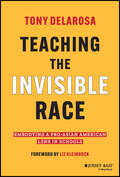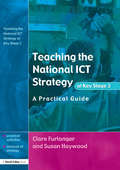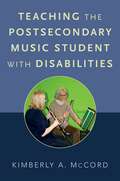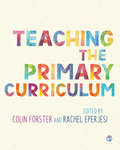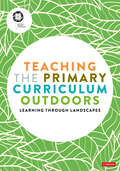- Table View
- List View
Teaching the Holocaust in School History: Teachers or Preachers?
by Lucy Russell If we expose students to a study of human suffering we have a responsibility to guide them through it. But is this the role of school history? This issue is the rationale behind teaching the Holocaust primarily historical, moral or social? Is the Holocaust to be taught as a historical event, with a view to developing students' critcal historical skills, or as a tool to combat continuing prejudice and discrimination?These profound questions lie at the heart of Lucy Russell's fascinating analysis of teaching the Holocaust in school history. She considers how the topic of the Holocaust is currently being taught in schools in the UK and overseas. Drawing on interviews with educationalists, academics and teachers, she discovers that there is in fact a surprising lack of consensus regarding the purpose of, and approaches to, teaching the Holocaust in history. Indeed the majority view is distinctly non-historical; there is a tendency to teach the Holocaust from a social and moral perspective and not as history. This book attempts to explain and debate this phenomenon.
Teaching the Humanities
by Peter GordonFirst Published in 1991. Routledge is an imprint of Taylor & Francis, an informa company.
Teaching the Humanities
by Peter GordonFirst Published in 1991. Routledge is an imprint of Taylor & Francis, an informa company.
Teaching the Invisible Race: Embodying a Pro-Asian American Lens in Schools
by Tony DelaRosaTransform How You Teach Asian American Narratives in your Schools! In Teaching the Invisible Race, anti-bias and anti-racist educator and researcher Tony DelaRosa (he, siya) delivers an insightful and hands-on treatment of how to embody a pro-Asian American lens in your classroom while combating anti-Asian hate in your school. The author offers stories, case studies, research, and frameworks that will help you build the knowledge, mindset, and skills you need to teach Asian-American history and stories in your curriculum. You’ll learn to embrace Asian American joy and a pro-Asian American lens—as opposed to a deficit lens—that is inclusive of Brown and Southeast Asian American perspectives and disability narratives. You’ll also find: Self-interrogation exercises regarding major Asian American concepts and social movements Ways to center Asian Americans in your classroom and your school Information about how white supremacy and anti-Blackness manifest in relation to Asian America, both internally and externallyAn essential resource for educators, school administrators, and K-12 school leaders, Teaching the Invisible Race will also earn a place in the hands of parents, families, and community members with an interest in advancing social justice in the Asian American context.
Teaching the Invisible Race: Embodying a Pro-Asian American Lens in Schools
by Tony DelaRosaTransform How You Teach Asian American Narratives in your Schools! In Teaching the Invisible Race, anti-bias and anti-racist educator and researcher Tony DelaRosa (he, siya) delivers an insightful and hands-on treatment of how to embody a pro-Asian American lens in your classroom while combating anti-Asian hate in your school. The author offers stories, case studies, research, and frameworks that will help you build the knowledge, mindset, and skills you need to teach Asian-American history and stories in your curriculum. You’ll learn to embrace Asian American joy and a pro-Asian American lens—as opposed to a deficit lens—that is inclusive of Brown and Southeast Asian American perspectives and disability narratives. You’ll also find: Self-interrogation exercises regarding major Asian American concepts and social movements Ways to center Asian Americans in your classroom and your school Information about how white supremacy and anti-Blackness manifest in relation to Asian America, both internally and externallyAn essential resource for educators, school administrators, and K-12 school leaders, Teaching the Invisible Race will also earn a place in the hands of parents, families, and community members with an interest in advancing social justice in the Asian American context.
Teaching the Language Arts: Forward Thinking in Today's Classrooms
by Elizabeth Dobler Denise Johnson Thomas DeVere WolseyTeaching the Language Arts helps readers envision their future classrooms, including the role technology will play, as they prepare to be effective teachers. The book’s multimedia digital format represents a distinctive way to learn about teaching—combining traditional and electronic content, resources, and pedagogy to create a powerful, interactive experience that encourages active learning. Readers can explore a rich array of teaching tools and experiences, including an effective blend of classroom photographs (taken by the authors during school visits), student samples, podcast interviews with teachers and students, classroom videos, and online resources—all of which allow readers to learn from real-world classrooms. This book’s unique and engaging voice, supported by its multimedia approach, will help future and in-service teachers bring the language arts to life in their own classrooms. Visit the Companion Website at www.routledge.com/cw/dobler for information on accessing the interactive e-book and additional ideas and resources to help you and your students use it to its full potential.
Teaching the Language Arts: Forward Thinking in Today's Classrooms
by Elizabeth Dobler Denise Johnson Thomas DeVere WolseyTeaching the Language Arts helps readers envision their future classrooms, including the role technology will play, as they prepare to be effective teachers. The book’s multimedia digital format represents a distinctive way to learn about teaching—combining traditional and electronic content, resources, and pedagogy to create a powerful, interactive experience that encourages active learning. Readers can explore a rich array of teaching tools and experiences, including an effective blend of classroom photographs (taken by the authors during school visits), student samples, podcast interviews with teachers and students, classroom videos, and online resources—all of which allow readers to learn from real-world classrooms. This book’s unique and engaging voice, supported by its multimedia approach, will help future and in-service teachers bring the language arts to life in their own classrooms. Visit the Companion Website at www.routledge.com/cw/dobler for information on accessing the interactive e-book and additional ideas and resources to help you and your students use it to its full potential.
Teaching the Language Arts: Forward Thinking in Today's Classrooms
by Denise Johnson Elizabeth Dobler Thomas DeVere WolseyThis book helps readers envision their future classrooms, including the role technology will play, as they prepare to be successful teachers. Comprehensively updated, the second edition addresses new demands on teaching in traditional and virtual ELA classrooms, and the new ways technology facilitates effective instructional practices. Organized around the receptive language arts—the way learners receive information—and the expressive language arts—the way leaners express ideas—chapters cover all aspects of language arts instruction, including new information on planning and assessment; teaching reading and writing fundamentals; supporting ELLs, dyslexic, and dysgraphic learners; using digital tools; and more. In every chapter, readers can explore a rich array of teaching tools and experiences, which allow readers to learn from real-world classrooms. The eBook+ version includes interactive features and links to the up-to-date Companion Website, with more strategies, and examples of practice and student work. This book’s unique and engaging voice, supported by its many resources, will help future and in-service teachers bring the language arts to life in their own classrooms.
Teaching the Language Arts: Forward Thinking in Today's Classrooms
by Denise Johnson Elizabeth Dobler Thomas DeVere WolseyThis book helps readers envision their future classrooms, including the role technology will play, as they prepare to be successful teachers. Comprehensively updated, the second edition addresses new demands on teaching in traditional and virtual ELA classrooms, and the new ways technology facilitates effective instructional practices. Organized around the receptive language arts—the way learners receive information—and the expressive language arts—the way leaners express ideas—chapters cover all aspects of language arts instruction, including new information on planning and assessment; teaching reading and writing fundamentals; supporting ELLs, dyslexic, and dysgraphic learners; using digital tools; and more. In every chapter, readers can explore a rich array of teaching tools and experiences, which allow readers to learn from real-world classrooms. The eBook+ version includes interactive features and links to the up-to-date Companion Website, with more strategies, and examples of practice and student work. This book’s unique and engaging voice, supported by its many resources, will help future and in-service teachers bring the language arts to life in their own classrooms.
Teaching the Literature of Today's Middle East
by Allen WebbProviding a gateway into the real literature emerging from the Middle East, this book shows teachers how to make the topic authentic, powerful, and relevant. Teaching the Literature of Today’s Middle East:• Introduces teachers to this literature and how to teach it• Brings to the reader a tremendous diversity of teachable texts and materials by Middle Eastern writers • Takes a thematic approach that allows students to understand and engage with the region and address key issues • Includes stories from the author’s own classroom, and shares student insight and reactions• Utilizes contemporary teaching methods, including cultural studies, literary circles, blogs, YouTube, class speakers, and film analysis• Directly and powerfully models how to address controversial issues in the region Written in an open, personal, and engaging style, theoretically informed and academically smart, highly relevant across the field of literacy education, this text offers teachers and teacher-educators a much needed resource for helping students to think deeply and critically about the politics and culture of the Middle East through literary engagements.
Teaching the Literature of Today's Middle East
by Allen WebbProviding a gateway into the real literature emerging from the Middle East, this book shows teachers how to make the topic authentic, powerful, and relevant. Teaching the Literature of Today’s Middle East:• Introduces teachers to this literature and how to teach it• Brings to the reader a tremendous diversity of teachable texts and materials by Middle Eastern writers • Takes a thematic approach that allows students to understand and engage with the region and address key issues • Includes stories from the author’s own classroom, and shares student insight and reactions• Utilizes contemporary teaching methods, including cultural studies, literary circles, blogs, YouTube, class speakers, and film analysis• Directly and powerfully models how to address controversial issues in the region Written in an open, personal, and engaging style, theoretically informed and academically smart, highly relevant across the field of literacy education, this text offers teachers and teacher-educators a much needed resource for helping students to think deeply and critically about the politics and culture of the Middle East through literary engagements.
Teaching the Mother Tongue in a Multilingual Europe
by Witold Tulasiewicz Anthony AdamsIn a time when the increasing cultural diversity and population mobility of the continent calls for good communication skills, this fascinating book features a wealth of data and critical opinion on the topic of mother tongue education.In the first part of the book, the two editors address central cultural, political and educational concerns relating to the mother tongue, using some of the findings of their European Commission funded research on the changing European classroom. The second part presents case study articles by practitioners from nine countries which have significant regional or immigrant mother tongue populations. These include Welsh in Wales, Catalan and Galician in Spain, Turkish and Greek in Germany, Arabic and Corsican in France, and Belorussian in Poland, as well as critical accounts of the main first language situation in England, Denmark, France, Germany, Poland, post-Soviet Russia, and Spain. The concluding part of the book looks at language awareness as a possible approach to linguistic diversity. It examines the preparation of teachers at all levels, as experinced by the editors through their involvement in an in international language study group based in Calgary, Cambridge, Mainz and Bialystock.Teaching the Mother Tongue in a Multilingual Europe is packed with original information which will be of use to all teachers and educationalists concerned with language.
Teaching the National ICT Strategy at Key Stage 3: A Practical Guide
by Clare Furlonger Susan HaywoodFirst Published in 2005. Routledge is an imprint of Taylor & Francis, an informa company.
Teaching the National ICT Strategy at Key Stage 3: A Practical Guide
by Clare Furlonger Susan HaywoodFirst Published in 2005. Routledge is an imprint of Taylor & Francis, an informa company.
Teaching the National Strategy at Key Stage 3: A Practical Guide
by Pat Perks Stephanie PrestageNational Numeracy Strategy (NNS) for Key Stage 3 will be introduced into Secondary Schools in September 2001. The NNS document: Framework for Teaching Mathematics in Years 7 to 9, is based on the National Curriculum, but offers a very different interpretation of some of the expected learning outcomes for year 7 to 9. This practical book, interprets and explains the document for busy practitioners, spells out the expectations of the framework and offers guidance on how to fulfil these, describes and explains the types of teaching methods for maximising students' learning, and includes many practical ideas for classroom activities within the framework of the NNS.
Teaching the National Strategy at Key Stage 3: A Practical Guide
by Pat Perks Stephanie PrestageNational Numeracy Strategy (NNS) for Key Stage 3 will be introduced into Secondary Schools in September 2001. The NNS document: Framework for Teaching Mathematics in Years 7 to 9, is based on the National Curriculum, but offers a very different interpretation of some of the expected learning outcomes for year 7 to 9. This practical book, interprets and explains the document for busy practitioners, spells out the expectations of the framework and offers guidance on how to fulfil these, describes and explains the types of teaching methods for maximising students' learning, and includes many practical ideas for classroom activities within the framework of the NNS.
Teaching the Postsecondary Music Student with Disabilities
by Kimberly A. McCordTeaching the Postsecondary Music Student with Disabilities provides valuable information and practical strategies for teaching the college music student. With rising numbers of students with disabilities in university music schools, professors are being asked to accommodate students in their studios, classes, and ensembles. Most professors have little training or experience in teaching students with disabilities. This book provides a resource for creating an inclusive music education for students who audition and enter music school. Teaching the Postsecondary Music Student with Disabilities covers all of the topics that all readers need to know including law, assistive technology, high-incidence and low-incidence disabilities, providing specific details on the disability and how it impacts the learning of the music student.
Teaching the Primary Curriculum
by Colin Forster Rachel EperjesiPlanning for authentic learning begins with engaging children. This book explores each subject in the primary curriculum offering clear guidance on the distinctive elements of each and effective pedagogical approaches that support informed teaching. Key aspects include: · Real-life case studies including student teacher and expert commentaries · Critical tasks for reflection and evaluation with suggested responses · How effective teaching can nurture children&’s intellectual development This is essential reading for all students on primary initial teacher education courses including university-based (PGCE, BEd, BA with QTS), and schools-based (School Direct, SCITT, Teach First) routes into teaching.
Teaching the Primary Curriculum (UK Higher Education OUP Humanities & Social Sciences Education OUP)
by Jane Johnston Mark Charter Derek Bell* What is good teaching and learning in the primary school?* How can teachers manage the whole curriculum and still educate the whole child and raise standards?* How can teachers be in critical dialogue with each other and with the curriculum in their search for improvement?* What is the role of the teacher in the new primary curriculum?This wide ranging book seeks to address these questions and to provide a comprehensive overview of the whole primary curriculum. It aims to develop teaching throughout primary education and to support teachers in the effective delivery of the curriculum. There is a particular focus on recent changes in primary education. The contributors consider how teaching methodologies need to adapt to these changes to meet the needs of children and raise standards in school. Throughout the book, emphasis is placed on effective teaching and learning methodologies, the importance of quality interaction in the classroom, the role of the teacher in teaching and learning and the experience of the child. Exemplars of good teaching are provided in each chapter, as well as thought provoking ideas for good practice.
Teaching the Primary Curriculum
Planning for authentic learning begins with engaging children. This book explores each subject in the primary curriculum offering clear guidance on the distinctive elements of each and effective pedagogical approaches that support informed teaching. Key aspects include: · Real-life case studies including student teacher and expert commentaries · Critical tasks for reflection and evaluation with suggested responses · How effective teaching can nurture children&’s intellectual development This is essential reading for all students on primary initial teacher education courses including university-based (PGCE, BEd, BA with QTS), and schools-based (School Direct, SCITT, Teach First) routes into teaching.
Teaching the Primary Curriculum for Constructive Learning
by Michael Littledyke Laura HuxfordFirst Published in 1998. Routledge is an imprint of Taylor & Francis, an informa company.
Teaching the Primary Curriculum for Constructive Learning
by Michael Littledyke Laura HuxfordFirst Published in 1998. Routledge is an imprint of Taylor & Francis, an informa company.
Teaching the Primary Curriculum Outdoors
by Learning Through LandscapesResearch evidence consistently shows that an outdoor learning environment can improve behaviour, engagement and encourage more active participation in learning. So why keep learning in a classroom? In reality, we know the challenges teachers face. We know the barriers that get in the way of taking learning outside. Learning through Landscapes has three decades of experience supporting teachers with the everyday challenges of teaching outdoors. Through this real life understanding of teaching and step by step guidance, this book shows you that every curriculum subject in primary schools can be taught outdoors. Through the pages of this book, Learning through Landscapes shows you that learning outdoors not only improves the health, wellbeing and attainment of the children in your class - it also brings joy to your teaching.
Teaching the Primary Curriculum Outdoors
by Learning Through LandscapesResearch evidence consistently shows that an outdoor learning environment can improve behaviour, engagement and encourage more active participation in learning. So why keep learning in a classroom? In reality, we know the challenges teachers face. We know the barriers that get in the way of taking learning outside. Learning through Landscapes has three decades of experience supporting teachers with the everyday challenges of teaching outdoors. Through this real life understanding of teaching and step by step guidance, this book shows you that every curriculum subject in primary schools can be taught outdoors. Through the pages of this book, Learning through Landscapes shows you that learning outdoors not only improves the health, wellbeing and attainment of the children in your class - it also brings joy to your teaching.
Teaching the Primary Curriculum Outdoors
Research evidence consistently shows that an outdoor learning environment can improve behaviour, engagement and encourage more active participation in learning. So why keep learning in a classroom? In reality, we know the challenges teachers face. We know the barriers that get in the way of taking learning outside. Learning through Landscapes has three decades of experience supporting teachers with the everyday challenges of teaching outdoors. Through this real life understanding of teaching and step by step guidance, this book shows you that every curriculum subject in primary schools can be taught outdoors. Through the pages of this book, Learning through Landscapes shows you that learning outdoors not only improves the health, wellbeing and attainment of the children in your class - it also brings joy to your teaching.


